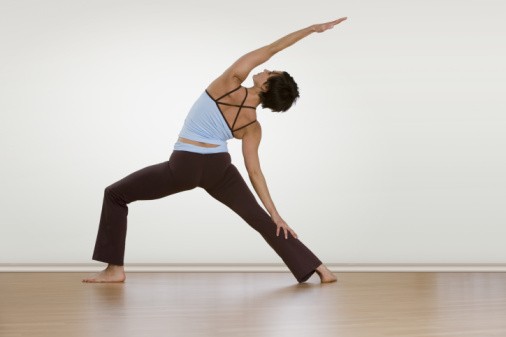How can we establish guidelines for preventing hip injuries in Yoga classes? Yoga is good for you. No, yoga is great for you. No one should ever dispute or deny that. However, the adage, “too much of a good thing,” can also be applied to practicing yoga and we have to create systematic methods for preventing injuries in our classes. Just because yoga has a good track record in comparison to other activities is not good enough. As more people become educated, the popularity of yoga continues to grow. Some people come into yoga classes with an overzealous approach that often backfires. It seems that the hips have proved to be a particularly vulnerable area to this overenthusiastic diving-in to the practice.
Flowing Into Wide Legged Forward Bend by paul-jerard
Doctors are reporting an increase in hip injuries. Upon investigation, it seems that many of the complaints are coming from avid yoga practitioners. Another commonality emerging is that most of the complaints are from women. Women’s bodies, built for reproduction have a wide range of motion in the pelvic area. This leads to the ability to push postures out of the normal range of movement. Over time, this leads to stress on the joint, and eventually injury.
It is easy to forget that all the basic yoga postures originated thousands of years ago in the East. The original yogis usually spent their days cross-legged or squatting on the floor. Visit the East even today and you will still see groups of people squatting while socializing.
How and Why we Should be Preventing Hip Injuries
This is just not so, outside of Asia. Most people spend most of the day sitting in chairs, cars, airplanes, or on sofas. This eventually leads to tightening of the hip joints. Keep in mind that most of your students walk in the door with tight hips. It is important to stress to everyone during the warm-up to open his or her hips slowly and gently.
Postures to be Modified for Preventing Hip Injuries:
• Sitting or Reclined Bound Angle Pose: Beginners can place blocks under their knees if hips do not open enough to allow knees to rest on the floor.
• Standing Frog: Many will not be able to get their feet flat on the ground and blankets under the heels can be helpful.
• Pigeon Pose: Placing a blanket under the sit bone or back of the thigh with the bent knee is a great way to modify this pose for those who need it.
• Warrior II: For those with limited flexibility, the stance can be shortened and front leg straightened to a level of comfort.
In addition, keep an eye on students that may be overextending the normal range of motion. With patience, your students will be able to attain the goal of increased flexibility and strength in the hip area, without risk of injuries.
© Copyright – Aura Wellness Center – Publications Division
See our testimonials to find out what our graduates have to say about teaching therapeutic yoga sessions and our selection of online yoga instructor training intensive courses.
If you are a teacher, yoga school manager, blogger, e-zine, or website publisher, and are in need of quality content, please feel free to use my blog entries (articles). Please be sure to reprint each article, as is. Namaste!
Related Posts
How Yoga Teachers Can Prevent Student Injuries
The Top Five Yoga Techniques Commonly Misaligned
About Hatha Yoga for Preventing Knee Injuries

